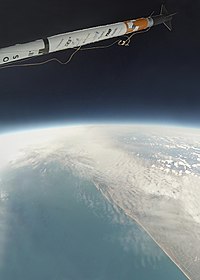astro.wikisort.org - Institution
El Arenosillo Test Centre (CEDEA) is the name of a rocket launch site for suborbital rockets managed by INTA, located near Mazagón in Spain.[2] It is located in the province of Huelva, Andalucía, in the southwest coast of Spain (37.1° N, 6.7° W).[3] CEDEA is adjacent to the Center of Excellence for Unmanned Systems (CEUS). El Arenosillo is also the location of an autonomous astronomical observatory of the BOOTES network , with two domes and three telescopes.
 | |
 | |
| Formation | 4 October 1966[1] |
|---|---|
| Type | rocket launch site |
| Location |
|
| Coordinates | 37.09687°N 6.73863°W |
| Owner | INTA (Spain) |
Director | Carlos Maestro Fernández |
Equipment
Among the main facilities that INTA has at CEDEA are (updated 2009):
- Two automatic telemetry systems (fixed and mobile) in S and L bands
- HF, UHF and VHF communications systems
- Airborne and maritime surveillance radars, NORTHCONTROL
- Mobile path radar, VITRO RIR 778X, 250 Kw
- Radar path, TRACOR RIR 779C, 1 Mw
- 1Mw VITRO RIR 778C mobile path radar with destruction command
- Three autonomous mobile optronic stations, MSP 2000, equipped with IR, TV, cinema and radar sensors (3D, high precision and with telemetric capabilities)
- Weather center with real-time information, satellite data reception and complete radiosonde system
- Control center where all the information necessary for the supervision and monitoring of a launching operation (air traffic control, meteorology, cartography, sensor data integration, flight safety, etc.) is centralized.
- Evaluation center: preparation, analysis and evaluation of reports
- Two high speed cameras (10000 images/s)
Complementing the above, the Center also has:
- Meteorological laboratory and probe balloons
- Presentation and conference room
- Telemetry, radar and optronic workshops
- Mechanical workshop, electrical workshop, sanitary service and warehouses
- Accommodation service for operations
- Laboratory for photographic processing
In 2017 part of the equipment was damaged in a wildfire. In the years 2018 and 2019 INTA has dedicated part of its budget to replace damaged equipment.
Pads
Incomplete list of launch pads:
- Nike – 37.0978°N 6.7372°W Operational. Based on a modified Nike Hercules system
- Sermiat – Unoperational. Used for Centaure rockets
- Médano del Loro – Operational. Is an adjacent launch site managed by Spanish Army
Launch history
The first launch of a rocket from El Arenosillo took place 15 October 1966.[4] Up to 1994 a total of 557 rockets were launched from this base, mainly of the Skua type for atmospheric soundings and in collaboration with other countries.[5]
All rockets for atmospheric soundings in Spain are launched from El Arenosillo.
In 2015 Delft Aerospace Rocket Engineering broke the European altitude record for amateur rocketry by launching the Stratos II+ rocket to 21.5 km altitude from El Arenosillo.[6]
On 1 March 2017, Zero 2 Infinity tested its first rocket, a Bloostar prototype, in El Arenosillo.[7] A balloon took Bloostar to 25 km. At 25 km the ignition of the rocket took place. The goals of the mission were: (i) validation of the telemetry systems in Space conditions, (ii) controlled ignition, (iii) stabilization of the rocket, (iv) monitoring of the launch sequence, (v) parachute deployment, and finally, (vi) sea recovery. All these goals were achieved in full.[8]
In 2022 PLD Space is expected to launch its first rocket Miura 1 from El Arenosillo.
| Date (UTC) | Vehicle | Payload | Launch pad | Result | Remarks |
|---|---|---|---|---|---|
| 15 October 1966 | Skua | INTA, Carabela 4 Aeronomy / test | ? | Success | First launch, 81 km apogee |
| 19 July 1969 | INTA-255 | ? | ? | Success | |
| 20 December 1969 | INTA-255 | ? | ? | Success | |
| 22 December 1970 | INTA-255 | ? | ? | Success | |
| 12 January 1974, 19:12 | Skylark | H-GR-58 | ? | Success | |
| 27 June 1976 | Black Brant IV | ASTRO-6, EUV radiation | ? | Success | 720 km apogee |
| 18 February 1981 | INTA-300 | ? | Nike | Success | |
| 7 April 1992[9] | INTA-100 | ? | ? | Success | First launch of INTA-100. 120 km apogee |
| 21 October 1993 | INTA-300B | ? | Nike[10] | Success | |
| 16 April 1994 | INTA-300B | ? | Nike | Success | |
| 2015 | Stratos II+ | ? | ? | Success | 21.457 km (new European amateur record) |
| 1 March 2017 | Bloostar | ? | – | Success | Bloostar first test |
| 26 July 2018 | Stratos III | ? | ? | Failure | |
| 11 April 2019 | Miura 5 | None | ? | Success | Drop test 5 km |
| 23 October 2021[11] | Stratos IV | ? | ? | Failure (Aborted) | |
| 20 November 2021 | Bondar[12] | ? | ? | Success | 7.8 km apogee (Spanish amateur record)[13] |
| 2022 (Planned) | Miura 1 | Payload from ZARM | Médano del Loro | – | 153 km apogee expected |
Only some launches are listed here. For information on individual rockets, see the List of rockets launched from El Arenosillo.
References
- International Aerospace Abstracts. Technical Information Service, American Institute of Aeronautics and Astronautics. 1970.
- "Instituto Nacional de Técnica Aeroespacial". Archived from the original on 25 August 2012. Retrieved 22 August 2012.
- A. Méndez-Vilas (21 November 2005). Recent Advances in Multidisciplinary Applied Physics: Proceedings of the First International Meeting on Applied Physics (APHYS 2003) October 13–18th, 2003, Badajoz, Spain. Elsevier. pp. 173–. ISBN 978-0-08-044648-6.
- "ABC MADRID 16-10-1966 página 63 - Archivo ABC". 12 August 2019.
- "El Arenosillo". Archived from the original on 4 September 2003.
- "Zoeken".
- "El runrún: El Arenosillo mira al espacio | Huelva24 | Toda la información y noticias de Huelva".
- "Zero 2 Infinity Successfully Launches its First Rocket from the Edge of Space – Z2I". Z2I. 13 March 2017. Retrieved 9 May 2017.
- Rivera, Alicia (7 April 1992). "Lanzado con éxito el cohete lanzador español 'Inta-100' | Sociedad | EL PAÍS". El País.
- "El Centro de El Arenosillo celebra su 50 aniversario dedicando un monumento al cohete INTA 300 B - Huelva Buenas Noticias".
- "Twitter".
- "El Arenosillo acoge la campaña de pruebas de un cohete suborbital de sondeo".
- "Estudiants de l'ESEIAAT de la UPC llancen amb èxit el coet supersònic suborbital més potent de Catalunya".
Другой контент может иметь иную лицензию. Перед использованием материалов сайта WikiSort.org внимательно изучите правила лицензирования конкретных элементов наполнения сайта.
WikiSort.org - проект по пересортировке и дополнению контента Википедии